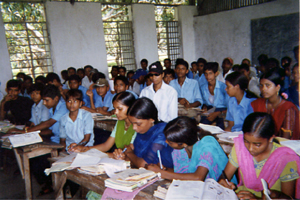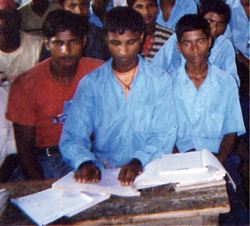 |
|
|
News |
Brief History of the School (2)Basbitti Secondary School, Basbitti, Mahottari District
By a resource teacher of Basbitti Secondary School
Location and Building: -  Basbitti village is situated, at a distance of about 12 km, to the north west of Jaleswar, the headquarter of Mahottari District. It is a middle-sized village, educationally, socially and economically quite backward. Formerly, there was a small traditional 'Village Pathshala' (Traditional School) in a small house. In course of time, it became a 5 classrooms primary school in 1956, where classes began to run from grade 1 to 5. After few years, it became a Lower Secondary School in 1974 and six and seven grades were added to. In 1981, it became a full-fledged Secondary School where teaching from grade 1 to 10 started. Besides, there is one nursery class as well. The school has altogether 16 well furnished brick-built classrooms, spacious and well ventilated apart from administrative block. Currently, there are altogether 1,000 students in this school. The number of girl-students is quite significant. About 15 percent of the total students come from backward, neglected and isolated classes and communities. All of them get monthly scholarship from the government as material incentives under the government's scholarship scheme. There are altogether 18 teachers: 9 for primary classes, 3 for lower secondary classes and 6 for secondary classes. As per government policy, there must be at least one lady teacher in primary section. So for 1,300 students have passed School Leaving Certificate (SLC) examination from the school. They are serving the country in different capacities. The school through its products have generated a feeling amongst the local rural population that education is the main agent of change and an effective instrument for social transformation. It has also brought a feeling amongst them that investment in education is an investment for future. Hostel Facilities: - For those who come from far off villages, there are hostel facilities for 80 boy students. Currently, 75 students are living in the hostel. For fooding, a mess is operation whose monthly charge per student is Rs. 750.00, which seems to be reasonable and affordable for the village students. The mess is run on self-management or contract basis, depending on the situation. Electricity, drinking water and toilet facilities are quite satisfactory. All the blind students now numbering 11 selected from the different parts of the 4 districts live in the hostel and lead a common community life. What an enjoyable scene it is to see the sighted students helping their blind friends in many ways! Blind Section: -  Blind section in the school was started in 1985 with the financial, material and technical help and cooperation of Christoffel Blinden Mission (CBM), Germany and Nepal Association for the Welfare of the Blind (NAWB), Kathmandu. So for 6 blind students have passed SLC examination, but their job-placement is being problem. Only half of them are gainfully employed and the other half are engaged in domestic works. Currently, there are 11 blind students attending different classes along with the sighted ones under the guidance and supervision of two resource teachers. Out of the 11 blind students, 6 have been sponsored by the CBM of Germany and the remaining 5 by the Tokyo Helen Keller Association (THKA), Japan. The parents of the five blind students, the local community and the school family as whole are very much grateful to TH KA for its meaningful help and co-operation to these lovely blind students. The school looks forward to continuing co-operation between the two institutes in the days to come. Resource Centre: - There is a Resource Centre in one of the rooms of the school staffed by a sensor, veteran, experiences and trained teacher. He helps other teachers including the teachers of the blind section as to how to use the new techniques and methods in teaching different subjects. He also teaches how to produce cheap teaching materials and aids out of the locally available raw materials. This has gone a long way to improve the quality of teaching, learning situation in the school. Library: - The school has a library of its own. One of the local NGOs has extended its help and co-operation by providing books, bookshelves and furniture. Nepali and English Newspapers and magazines are subscribed for the benefit of students and teachers. The library also serves as a common room for the students. Sports Facilities: - In the middle of the school compound, there is well-maintained playing ground with green grass all the year round, students play here different kinds of out door games and sports, such as, football, volley-ball, badminton, high jump, lung jump, shot-put, race, kabaddi, etc. There are provisions for in door games as well, such as, Carrim & Chese etc. One of the teachers has been assigned as game teacher. Even blind students are encouraged to participate in games of their choice. Sources of Income: - The total annual budget of the school is approximately 22 hundred thousand rupees (Rs. 2,200,000). Out of this amount, 80 percent come from the Minister of Education and Sports through the District Education Office. The rest 20 percent from school fees and from the landed property. In the same time, the amount received from THKA and CBM through NAWB for the residential study of the blind and visually impaired students is also the income of the school. The school has 18 Bighas (1,312,200 sq. ft.) of fertile land as its permanent asset in the area of Basbitti Village Development Committee, donated by local generous people. It has gone a long way to meet the financial constraints of the school. Need of Staff Quarters: - Out of 18 staff-members, those who come from far off places, stay with the students in the hostel and eat in the mess along with them. They also guide and supervise the students in their studies and help to maintain discipline and decorum amongst them including the blind ones. Thus, they create a congenial atmosphere for community living. The school has purchased a piece of land adjacent to the hostel for the construction of staff quarters. But, because of the paucity of funds, this could not be materialized so far. The management board and the teaching staff of this school have often expressed the views that any help for the construction of the staff-quarter will be highly appreciated. Saraswati (The Goddess of Learning) Temple: -  To the east of the main gate, is a colorful and well maintained Temple of Saraswati, which is a contribution of a local educationalist, built in the memory of his late mother, Mrs. Krishna Devi Shrestha. Students and teachers every morning and evening gather before the statue of Saraswati and pray together. It has added lustre to the atmosphere of the school. To the south of the temple is a row of beautiful coconut trees and to its west within the compound itself, is a big (Bar) tree with leafly branches spread up all around. Under this tree a spacious 'Chautara' (resting place) has been constructed in the memory of Prof. Bashudev Chand Mall, a noted educationalist and the ex-vice chancellor of Tribhuvan University. All the round year, particularly during summer, students, teachers and visitors rest and relax here. On the whole, the landscape of the school is very soothing. Finally, thank goes to THKA for the support for the education of the blind and visually impaired students and hope the support will be continuing in the days to come. |



